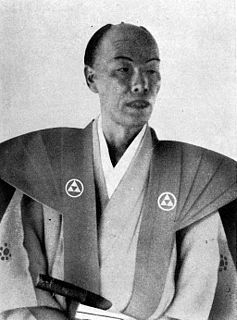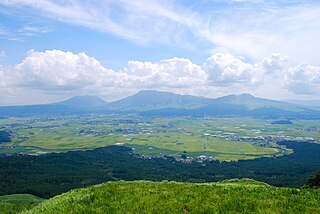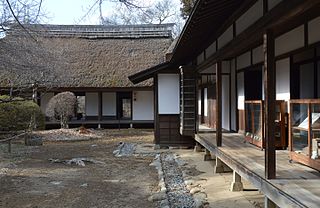
The daimyō were powerful Japanese feudal lords who, until their decline in the early Meiji period, ruled most of Japan from their vast, hereditary land holdings. In the term, dai (大) means "large", and myō stands for myōden(名田), meaning private land.

Yokoi Shōnan was a Bakumatsu and early Meiji period scholar and political reformer in Japan, influential around the fall of the Tokugawa bakufu. His real name was Yokoi Tokiari.

The Hosokawa clan was a Japanese samurai kin group or clan.

Kumamoto Castle is a hilltop Japanese castle located in Chūō-ku, Kumamoto, in Kumamoto Prefecture. It was a large and well fortified castle. The castle keep is a concrete reconstruction built in 1960, but several ancillary wooden buildings remain of the original castle. Kumamoto Castle is considered one of the three premier castles in Japan, along with Himeji Castle and Matsumoto Castle. Thirteen structures in the castle complex are designated Important Cultural Property.

Satsuma Domain, officially Kagoshima Domain, was a Japanese domain of the Edo period. It is associated with the provinces of Satsuma, Ōsumi and Hyūga in modern-day Kagoshima Prefecture and Miyazaki Prefecture on the island of Kyūshū.

BaronYamakawa Hiroshi was a samurai of late Edo period Japan who went on to become a noted general in the early Meiji period Imperial Japanese Army. An Aizu retainer famous for his ingenious strategies against the early Meiji government during the Boshin War to overthrow the Tokugawa bakufu, he was of the first people from Aizu to write a history of the years leading up to the war, together with his brother Yamakawa Kenjirō.

Matsudaira Yoshinaga, also known as Matsudaira Keiei, or better known as Matsudaira Shungaku (春嶽) was a Japanese daimyō of the Edo period. He was head of the Fukui Domain in Echizen Province. He is counted as one of the "Four Wise Lords of the Bakumatsu period", along with Date Munenari, Yamauchi Yōdō and Shimazu Nariakira. "Yoshinaga" is his imina and "Shungaku" is his gō.

The Kumamoto Domain, also known as Higo Domain, was a Japanese domain of the Edo period. It was associated with Higo Province in modern-day Kumamoto Prefecture.

Kitsuki Domain was a Japanese domain of the Edo period. It is associated with Bungo Province in modern-day Ōita Prefecture on the island of Kyūshū.

Kokura Domain', also known as "Kawara-han" (香春藩) or then "Toyotsu-han" (豊津藩), was a Japanese domain of the Edo period. It was associated with Buzen Province in modern-day Fukuoka Prefecture on the island of Kyushu.
Uto Domain, also known as Udo Domain, was a Japanese domain of the Edo period. It was associated with Higo Province in modern-day Kumamoto Prefecture.

The Hitoyoshi Domain was a Japanese domain of the Edo period. It was associated with Higo Province in modern-day Kumamoto Prefecture.

Tsugaru Nobuakira was the 8th daimyō of Hirosaki Domain in northern Mutsu Province, Honshū, Japan. His courtesy title was Tosa-no-kami, and his Court rank was Junior Fifth Rank, Lower Grade.
Yasunosuke Futa was a village chief and also an architect in Kumamoto Prefecture, Japan. He built an aqueduct, Tsujun Bridge, which improved the fertility of the land.
Saishunkan was a han medical school, established by Hosokawa Shigekata in 1756 in Kumamoto, Japan. Internal medicine, surgery, ophthalmology, pediatrics, gynecology, oral medicine, acupuncture, acupressure were taught.

The history of Kumamoto Prefecture has been documented from paleolithic times to the present. Kumamoto Prefecture is the eastern half of Hinokuni, and corresponds to what was once called Higo Province. Exceptions are the part of Kuma District, which had once been part of Sagara Domain, and Nagashima which was included in Kagoshima Prefecture.

The outline of the History of Kagoshima Prefecture, Japan is described herein.
Marume Nagayoshi was a retainer of the Sagara Clan in the Sengoku period and a swordsman in the early Edo period. He was considered one of the best four pupils of Kamiizumi Nobutsuna, and went on to found the Taisharyū school. He was sometimes known as Kurandonosuke and also as Ishimi Mamoru, but was best known as Marume Nagayoshi, which he was called in kōdan. His original name was Fujiwara, and his art name was Tessai. In his later years he shaved his head and went by the name of Ishimi Nyūdō Tessai.


















